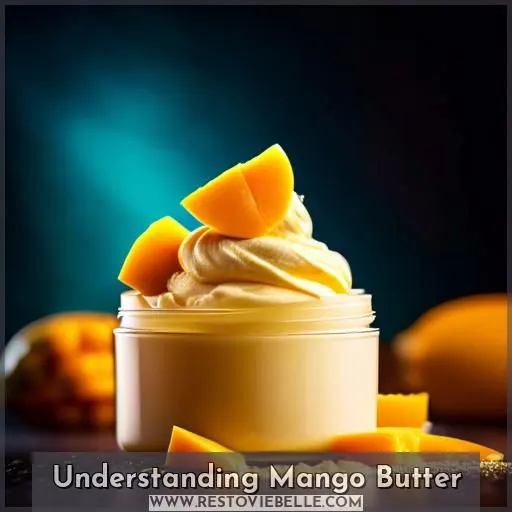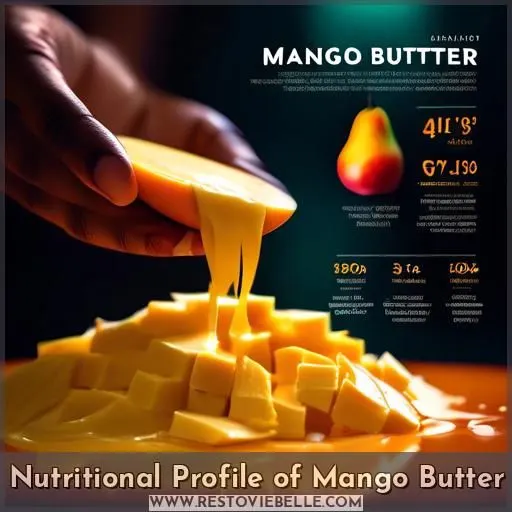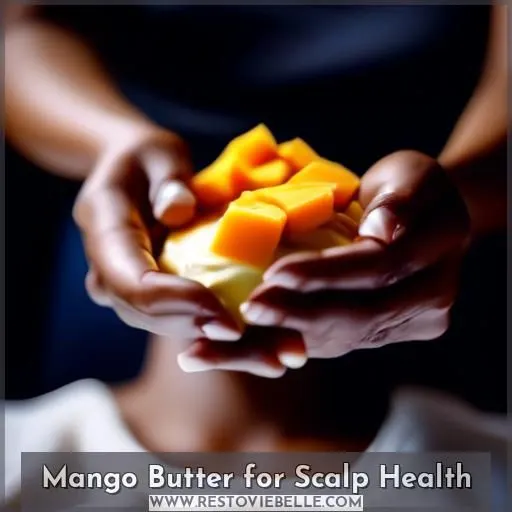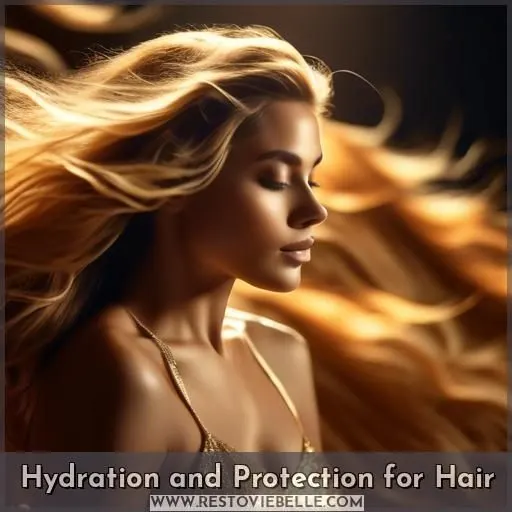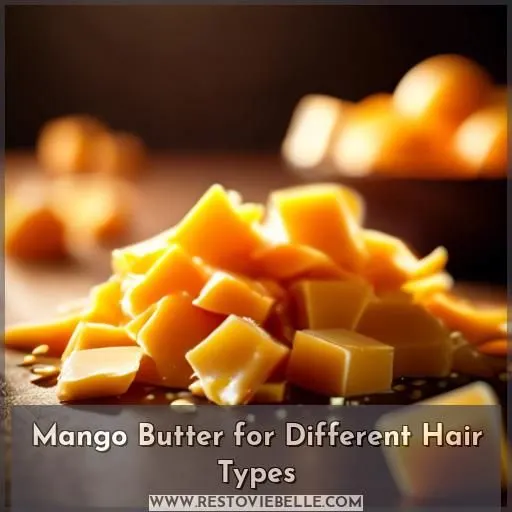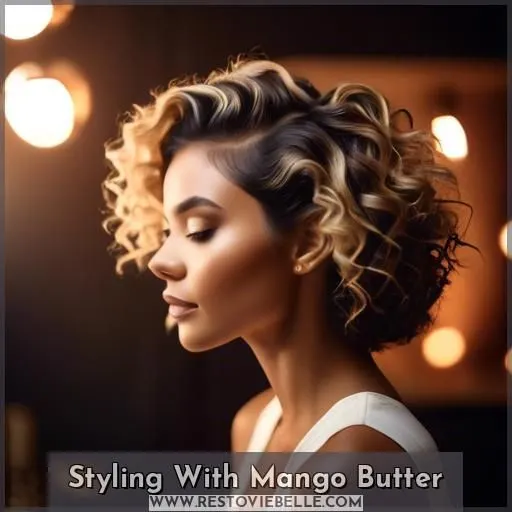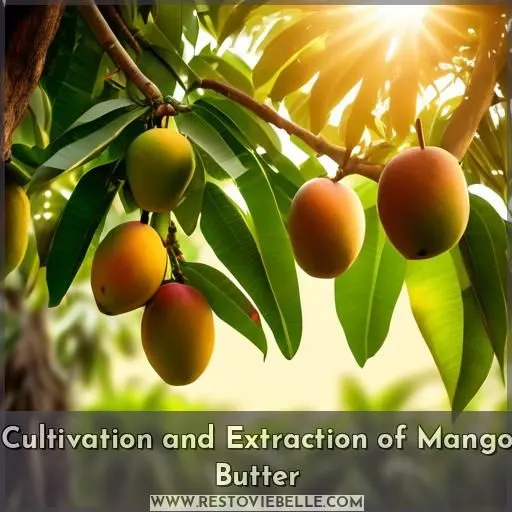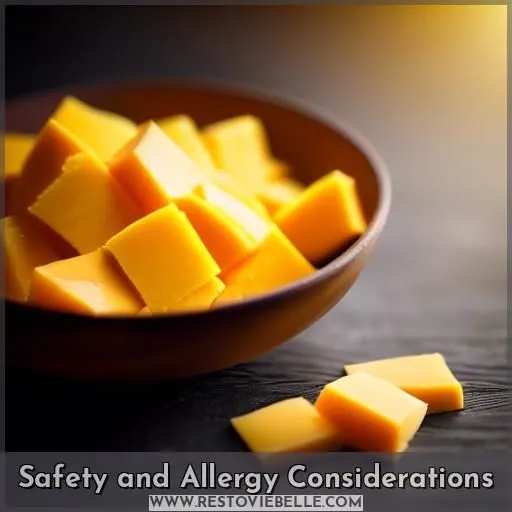This site is supported by our readers. We may earn a commission, at no cost to you, if you purchase through links.
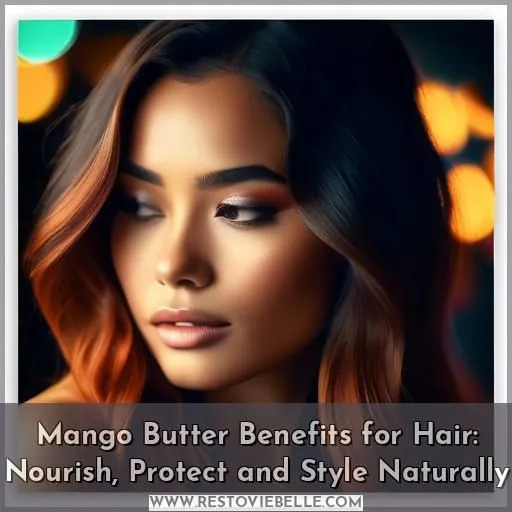 Mango butter benefits for hair? Embark on a journey into this ultra-nourishing tropical treasure!
Mango butter benefits for hair? Embark on a journey into this ultra-nourishing tropical treasure!
You’ll revel in its vitamin-rich, antioxidant prowess that safeguards strands from environmental aggressors.
Its fatty acids entrap moisture, bestowing hair with remarkable softness and luster while sealing the cuticle to ward off split ends.
Counteract scalp concerns with mango butter’s antifungal and antimicrobial attributes that alleviate dryness and flakes.
Foster a vibrant foundation for vigorous, radiant growth.
And styling? Mango butter disentangles, diminishes frizz, and shields against heat damage.
Uncover how to integrate this multifaceted elixir into your hair care regimen.
Table Of Contents
- Key Takeaways
- Understanding Mango Butter
- Nutritional Profile of Mango Butter
- Mango Butter for Scalp Health
- Hydration and Protection for Hair
- Mango Butter for Different Hair Types
- How to Apply Mango Butter
- Styling With Mango Butter
- Cultivation and Extraction of Mango Butter
- Safety and Allergy Considerations
- Frequently Asked Questions (FAQs)
- Conclusion
Key Takeaways
- Mango butter is a natural ingredient that offers numerous benefits for hair health, including essential fatty acids, vitamins A and E, and antioxidants.
- Mango butter can enhance scalp health by containing antifungal and antimicrobial properties, which can aid in maintaining a healthy scalp environment.
- Mango butter is an effective hydrating agent for hair, aiding in preventing split ends and reducing frizz. It can be used as a pre-poo treatment, added to shampoos or conditioners, or used to create hair masks.
- Mango butter is suitable for all hair types, especially those that are damaged or dry, and can be stored in a cool, dry place for up to 24 months when stored under ideal conditions.
Understanding Mango Butter
Let’s start by defining mango butter – it’s a rich, creamy, plant-based butter extracted from the seed kernel of the mango fruit. Steeped in history, this nourishing botanical was first used in India over 4,000 years ago for its powerful skin and hair benefits.
Definition and Composition
Mango butter is a multifaceted ingredient that offers countless benefits for hair well-being. It’s extracted from the seeds of mangoes and has a velvety, creamy texture at cool temperatures, transforming into a light, scentless oil when applied to the skin or hair. Mango butter is renowned for its nourishing qualities, as it contains essential fatty acids, vitamins A and E, and antioxidants.
One of the primary advantages of mango butter for hair is its capacity to enhance scalp health. It contains antifungal and antimicrobial properties, which can aid in maintaining a healthy scalp environment. Furthermore, mango butter is non-allergenic, making it appropriate for all hair types, especially those that are damaged or dry.
Mango butter is also an effective hydrating agent for hair, aiding in preventing split ends and reducing frizz. It can be employed as a pre-poo treatment prior to shampooing, added to shampoos or conditioners, or used to create hair masks. For low-porosity hair, it’s advisable to apply mango butter to soaking wet hair.
When using mango butter for hair, it’s crucial to store it appropriately to preserve its quality. It should be kept in a cool, dry place, away from light and excessive air exposure. Proper storage can help prolong the shelf life of mango butter, which typically lasts for around 24 months when stored under ideal conditions.
Historical Use and Origin
Mango butter, a natural ingredient derived from the seeds of the mango fruit, has a rich history that spans over four millennia. Originating in India as a traditional medicine, it has been used for various purposes, including moisturizing, healing, and rejuvenating the skin and hair. The fruit itself is called Manna in Malayalam, and its name in English is believed to have originated from this term.
Mango butter was introduced to the Western Hemisphere around 1700 and became an alternative to cocoa butter in the 1930s due to its similar properties and benefits. It was used in the confectionery industry as a substitute for cocoa butter and later found its place in skincare and hair care products.
In the 20th century, mango butter was used as a powerful agent for skin health promotion due to its rich antioxidant content, which includes phytosterols, tocopherol, and triterpenes. It has been used in various skincare products such as creams, lotions, balms, serums, masks, and other types of skincare products.
Today, mango butter is sourced from India, Africa, and South America and is used in a variety of cosmetic products for its moisturizing, antioxidant, anti-inflammatory, and calming properties, contributing to healthier, more vibrant, and well-nourished skin.
Nutritional Profile of Mango Butter
You’ll find mango butter to be a rich source of beneficial vitamins, fatty acids, and antioxidants. It contains vitamins A and E, along with fatty acids like oleic, stearic, and palmitic acids—all of which nourish your hair and scalp. The antioxidant properties of mango butter also help shield your strands from environmental stressors.
Vitamins and Fatty Acids
Mango butter is a natural ingredient that offers numerous benefits for hair health. It’s rich in essential fatty acids like oleic acid and linolenic acid, which help keep the hair protected and boost hair health with hydration. Additionally, mango butter contains vitamins A and E, which have a deep moisturizing and regenerative effect on both strands and scalp, fortifying strands from the inside out and reducing breakage and split ends. These vitamins also help regulate sebum production, which can reduce scalp dryness and flakiness, promoting a healthy scalp environment that supports better hair growth.
Mango butter’s fatty acid content aids in locking in moisture, leaving hair soft and shiny. It’s particularly beneficial for dry and damaged hair, as it penetrates the hair shaft and helps combat dryness. Moreover, mango butter has a lightweight texture that doesn’t make hair look greasy, making it a versatile ingredient for various hair types.
Incorporating mango butter into your hair care routine can have a positive impact on hair health by improving hydration, preventing hair breakage, and promoting a healthier scalp environment. It can be used in a variety of hair care products, such as shampoos, conditioners, and hair masks, to enhance their moisturizing properties and provide additional benefits for hair growth and elasticity.
Antioxidant Properties
Mango butter, rich in antioxidant properties, offers skin protection and anti-aging benefits. Its moisturizing effects contribute to hair nourishment, preventing split ends and heat damage. Vitamins A and E, found in mango butter, enhance its anti-aging properties. Incorporate this nutrient-rich product into your hair care routine for a more youthful appearance and healthier hair.
Mango Butter for Scalp Health
Mango butter’s antifungal and antimicrobial properties make it an excellent choice for promoting a healthy scalp environment. By nourishing dry, flaky scalp areas, it can alleviate itchiness and irritation, creating the ideal foundation for strong, lustrous hair growth.
Antifungal and Antimicrobial Benefits
Just like a superhero for your scalp, mango butter swoops in to tackle the villains of itchy scalp, dandruff, and scalp sores.
It promotes hair growth with every scalp massage.
Regardless of your hair type, incorporating mango butter into your hair care routine is like giving your scalp a shield against the baddies.
It whispers sweet nothings of nourishment and care.
Nourishing Dry Scalp
Mango butter is a natural ingredient that can help nourish a dry scalp, providing relief for conditions like scalp inflammation, dandruff, psoriasis, and eczema.
Its antifungal and antimicrobial properties make it a great choice for scalp health.
Its fatty acids and vitamins contribute to skin repair and hair growth stimulation.
Incorporate mango butter into your hair care routine with pre-poo treatments, shampoos, conditioners, hair masks, and styling products.
Explore recipes for deep conditioning treatments.
Enjoy the benefits of this versatile ingredient for your hair and scalp.
Hydration and Protection for Hair
You’ll be thrilled to know that mango butter’s nourishing properties can help prevent those dreaded split ends. Its natural oils envelop each strand, sealing the cuticle to lock in moisture and protect your color from fading. Plus, mango butter’s heat-protecting abilities allow you to style with confidence, shielding your hair from the damaging effects of hot tools.
Preventing Split Ends
Mango butter is a natural powerhouse for hair health. It offers antioxidant protection, stimulates hair growth, and reduces frizz. By deeply conditioning your hair, mango butter helps repair damage and keeps your strands strong. Whether you’re dealing with split ends or just want to maintain healthy locks, this versatile ingredient is your go-to.
Color Fading and Heat Damage
Mango butter is a natural powerhouse.
It not only hydrates your hair but also offers color protection and heat damage resistance.
By incorporating mango butter into your hair care routine, you can strengthen your hair, restore its natural shine, and even promote hair growth.
Whether you’re dealing with damaged hair or simply want to maintain healthy locks, mango butter is a must-have ingredient for anyone seeking to shield their hair from the elements.
Mango Butter for Different Hair Types
Mango butter is suitable for all hair types, but it shines brightest for those with damaged or dry hair. When applying it, adjust your method – use it as a deep conditioner for thin hair or a leave-in conditioner for thick hair. For low-porosity hair, apply mango butter to soaking wet strands to allow better absorption.
Application for Low-Porosity Hair
If you’re dealing with low-porosity hair, you know the struggle of moisture retention and damage repair.
Mango butter is your styling aid savior.
Apply it to soaking wet hair before styling to enhance moisture retention.
For leave-in conditioners, mix mango butter with other natural ingredients like aloe vera or coconut oil to create a nourishing blend.
This will help repair damage and protect your hair from further harm.
Conditioning for Thin and Thick Hair
Just as a master chef knows the perfect recipe for each dish, your hair deserves a customized approach.
For thin hair, mango butter is a deep conditioning miracle, transforming brittle strands into silk.
Got thick locks? A dollop of this golden elixir as a leave-in conditioner can tame the wildest mane.
Mix it into hair masks or styling products, and even low-porosity hair will absorb the benefits.
How to Apply Mango Butter
You can nourish and protect your hair with mango butter in several ways. Before shampooing, apply it as a pre-poo treatment to hydrate strands and improve manageability; blend it into shampoos and conditioners for added nourishment; or create a luxurious hair mask by mixing mango butter with other beneficial oils and ingredients.
Pre-Shampoo Treatment
Before shampooing, applying mango butter as a pre-poo treatment can yield impressive benefits.
This technique helps to lock in moisture, prevent split ends, and protect hair from color fading and heat damage.
To apply, warm a small amount in your hands and gently massage it into your scalp and hair.
For a DIY treatment, mix mango butter with essential oils and apply before shampooing.
Product recommendations include the Aaron Wallace Hydrating Shampoo and Klorane Nourishing Leave-In Cream with Mango Butter.
Always be aware of potential allergies and discontinue use if irritation occurs.
Enhancing Shampoos and Conditioners
Mango butter is a versatile ingredient that can be used in various ways to enhance the performance of your shampoos and conditioners. Here’s how you can incorporate mango butter into your hair care routine:
- Add to Shampoo or Conditioner: You can add a small amount of mango butter to your shampoo or conditioner to enhance their moisturizing properties. Simply melt a small amount of mango butter and mix it with your shampoo or conditioner before use. This will provide an extra boost of hydration to your hair.
- Create a Hair Mask: Mix mango butter with other nourishing ingredients like coconut oil or honey to create a deep conditioning hair mask. Apply this mixture to your hair, focusing on the ends, and leave it on for 30 minutes to an hour before rinsing it out. This will help lock in moisture and protect your hair from damage.
- Use in Leave-in Conditioners: If you have thick hair, you can use mango butter as a leave-in conditioner. Melt a small amount and mix it with your favorite essential oil. Apply this mixture to your hair and style as usual. This will help keep your hair hydrated and manageable throughout the day.
- Apply as a Pre-Shampoo Treatment: Before washing your hair, apply a small amount of melted mango butter to your scalp and hair. This will help protect your hair from the harshness of shampoo and provide an extra layer of hydration.
Creating Hair Masks
Creating Hair Masks with Mango Butter: DIY Treatments for Healthy Hair
Mango butter is a versatile ingredient that can be used in various hair treatments, including hair masks. These masks can help nourish your hair, prevent split ends, and promote scalp health. Here are some ways to use mango butter in hair masks:
- Mango Butter Hair Mask Recipe:
- 2 tablespoons mango butter
- 1 tablespoon olive oil
- 1 teaspoon honey
- 2-3 drops of your favorite essential oil
- Melt the mango butter, then mix with olive oil, honey, and essential oil. Apply to your hair, let it sit for 30-45 minutes, and rinse with warm water.
- Mango Butter Deep Conditioning Mask:
- ¼ cup cocoa butter
- ¼ cup mango butter
- ⅛ cup coconut oil
- 1 g vitamin E oil
- ¼ cup chamomile-infused olive oil or just olive oil
- ¼ teaspoon arrowroot powder (optional)
- 20 drops of lavender essential oil (optional)
- Melt the mango butter, cocoa butter, and coconut oil, then add the chamomile infused oil, vitamin E, and essential oil. Allow the mixture to cool and harden, then whip it until creamy and foamy. Apply to your hair and leave it on for an hour before rinsing.
- Mango Butter Hair Cream Recipe:
- 60 ml of mango butter
- 1 tablespoon of cocoa butter chips
- 1 tablespoon of avocado oil
- 1 teaspoon of jojoba oil
- 1 teaspoon of almond oil
- 1 teaspoon of…
- Melt the mango butter, cocoa butter, and avocado oil, then mix with jojoba oil and almond oil. Apply to damp hair as a leave-in conditioner.
These hair masks can be used once or twice a week, depending on your hair’s needs. Remember to apply the mask evenly throughout your hair, focusing on the ends and damaged areas. After using the mask, rinse your hair thoroughly to remove any excess product.
Incorporating mango butter into your hair care routine can provide numerous benefits, such as promoting scalp health, hydrating your hair, and preventing split ends. Experiment with these DIY hair treatments to find the perfect combination for your hair type and needs.
Styling With Mango Butter
To style naturally with mango butter, you can’t go wrong with leave-in conditioners. They allow the rich fatty acids and vitamins to penetrate strands, sealing in moisture while providing heat protection and reducing frizz. Simply work a nickel-sized amount through damp hair after showering, focusing on mid-lengths and ends.
Leave-in Conditioners
Embrace the power of mango butter for your hair with leave-in conditioners. These products are perfect for thick hair, providing deep conditioning without weighing it down. For high porosity hair, an overnight treatment can work wonders. And don’t forget about detangling benefits – mango butter is your new best friend in the hair care world!
Cultivation and Extraction of Mango Butter
Mango trees thrive in tropical and subtropical regions, cultivated extensively in India, where the trees are native. To extract mango butter, the seeds are cold-pressed or expelled after harvesting the fruit, yielding a rich, creamy butter packed with nourishing vitamins and fatty acids.
Growing Mango Trees
To cultivate mango trees for that luscious mango butter, you’ll need sandy loam soil with excellent drainage.
Utilize grafting techniques to guarantee resistance to disease and vigorous growth.
Control pests with effective management.
Bear in mind, the proper fertilizer combination works wonders for your tree’s well-being.
It’s a delicate balance of nature and care to produce the creamiest mango kernels.
Harvesting and Processing Seeds
Essential steps in the production of mango butter involve harvesting and processing mango seeds. Mango butter is sourced from the seeds of ripe mango fruits, which abound in fatty acids and antioxidants**.
Two primary techniques exist for extracting mango butter: expeller-pressing and cold-pressing. Expeller-pressed mango butter originates from crushing the seeds and expelling the oil, while cold-pressed mango butter employs a hydraulic press operating at low temperatures to safeguard the butter’s inherent qualities. Both methods yield a premium, nutrient-laden butter applicable in diverse domains such as cosmetics, food, and pharmaceuticals.
Sustainability holds paramount importance in mango butter production. Mango trees, originating from India, thrive in sandy loam soil with adequate drainage. Their ideal pH range lies between 5.2 and 7.5, and they can reach heights of 130 feet. Grafting serves as the propagation method, and seeds are harvested once the fruit reaches maturity.
Mango butter boasts a shelf life of approximately two years under appropriate storage conditions in a cool, dry place shielded from light and excessive air exposure. Adhering to proper storage guidelines is fundamental to upholding the butter’s quality and preventing oxidation and contamination.
The global mango butter industry is experiencing growth, with the Asia-Pacific region leading the surge due to escalating demand for natural and plant-based components in cosmetics and personal care products. Key players in the global mango butter market include Hallstar BIOCHEMICA, Manorama, Jarchem Industries, AOT, Alzo International Incorporated, EKOLOGIE FORTE PVT., and Avi Natural.
Safety and Allergy Considerations
You’ll be pleased to know that mango butter is non-comedogenic, meaning it won’t clog your pores. However, as with any new product, it’s wise to do a patch test first if you have allergies or sensitivities, as some people may react to components in mango butter.
Non-Comedogenic Nature
Just as you wouldn’t want your favorite hat to leave you feeling boxed in, your hair care shouldn’t suffocate your scalp. Enter mango butter, the non-comedogenic hero that’s as breathable as your go-to summer tee. It’s hypoallergenic, virtually odorless, and a seamless substitute for shea butter. Think of it as a deep conditioner that gives your locks room to breathe.
Allergy Information
Mango butter is generally safe for most people, but those with allergies should exercise caution. Cross-reactivity with other nut-based products is a concern, so it’s crucial to patch test before using mango butter on your hair or skin. If you experience irritation or any adverse reactions, discontinue use promptly.
Frequently Asked Questions (FAQs)
How long does mango butter last?
You’re in luck, my friend! Properly stored mango butter has a shelf life of around 2-3 years. Keeping it cool and airtight is key to maintaining its luscious, hair-pampering powers for the long haul. So stock up and let those locks bask in buttery bliss!
Can mango butter be used on oily hair?
Y’all’s hair gon’ be shinin’ like a disco ball! Mango butter can absolutely be used on oily hair – it’s lightweight, non-greasy, and deeply nourishing without weighing strands down. A little dab’ll do ya, preventing frizz while adding moisture and shine.
How much mango butter should I use?
You’ll want to use just a pea-sized amount of mango butter on your ends or a bit more for an all-over treatment. A little goes a long way with this ultra-nourishing natural butter!
Does mango butter cause hair loss?
Imagine this: your luxurious tresses cascading down in bunches due to mango butter? Never! This nourishing delicacy is a hair savior, not a hair saboteur. Mango butter hydrates parched strands, preventing breakage and thinning rather than causing it. Your crowning glory will express its gratitude for the indulgent treat.
Can mango butter be used for beard care?
Absolutely! Mango butter makes an excellent beard conditioner and softener. Its rich oils lock in moisture, taming frizz and preventing those pesky split ends. Smooth a dab onto your beard after showering for an enviably lush, healthy look.
Conclusion
Like a verdant tropical haven, mango butter’s virtues for hair reveal a treasure trove of nourishing delights. You’ll bask in its vitamin-laden glory, protecting tresses from harm while trapping moisture for unparalleled softness. Yield to this versatile essence, and your hair will thrive with vibrant allure – a profound tribute to nature’s nurturing embrace.

